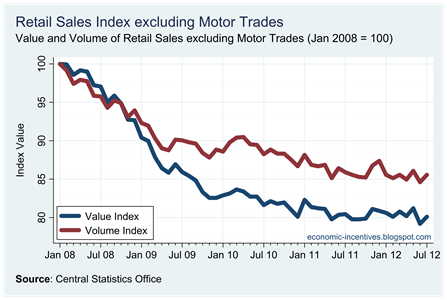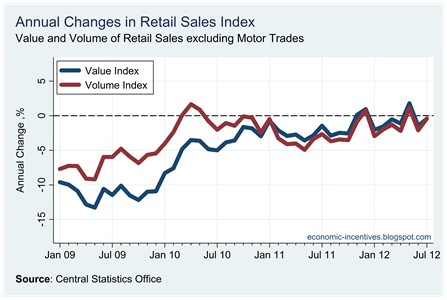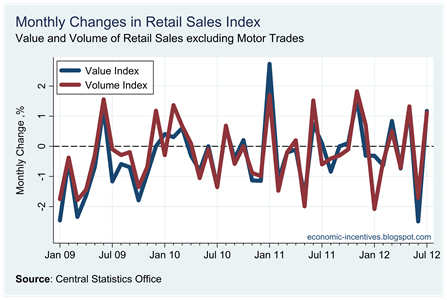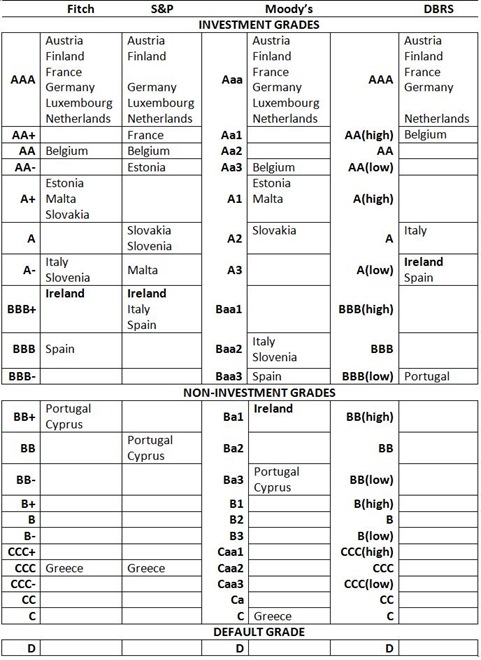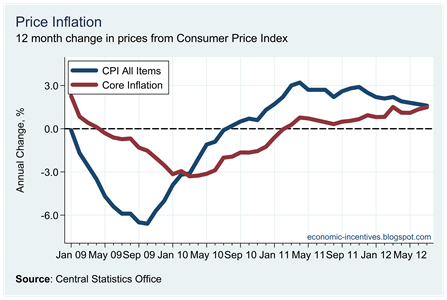A report on the Irish mortgage market has attracted a lot of attention and in particular one projection contained in it.
These reports accurately reflect the press statement released by Fitch. However, in an examination of the full report it is difficult to find the projection that 20% of mortgages (owner-occupied and buy-to-let) are expected to default. Here is the first ‘key highlight’ on page 1:
Increased Foreclosure Frequency Expectations: The foreclosure Frequency (FF) assumptions for ‘Bsf’ and ‘AAsf’ rating categories have been adjusted upwards, due to worse-than-expected mortgage and house price performance. The ‘Bsf’ base FF for a standard mortgage portfolio has been increased to 10.0% from about 7.5%. The ‘AAsf’ base FF assumption is now 25%, up from 15% in the 2011 criteria.
To explain this a bit on page 6 we are told a bit more about the base foreclosure frequency expectations:
The expected FFs at the ‘Bsf‘ rating level, [.], reflect the default risk of an Irish residential mortgage loan with the following characteristics (‘standard loan‘):
- loan is not in arrears;
- full-time employed borrower with full income verification and no adverse credit history;
- amortising loan paying monthly; and
- loan purpose consisting of purchase/refinancing of the primary residence.
Thus, Fitch have increased their default expectation on what would be considered currently performing loans to 10%. Fitch then adjust the foreclosure frequency from this base level of 10% based on the characteristics of the loan. For example, loans with a poorer performance will be assigned higher default expectations. The table on page 12 reflects this.

The base category for performing loans is reflected in the 10% figure in the bottom left hand corner. The increase in the default expectations can be seen by moving out along the row. At the end of the row it can be seen that there is a default expectation of 70% for loans that are more than 3 months in arrears.
The rows further up the table reflect different risk scenarios with the highest risk ‘AAsf’ scenario is “commensurate with a severe continued economic downturn” which includes a “peak-to-trough house price decline assumption is 72%”. Fitch believes this and other assumptions are “sufficiently remote” for this high rating scenario. In the ‘AAsf’ the base foreclosure frequency used is 2.5 times that in the ‘Bsf’ scenario, i.e 25%. The intermediate risk scenarios have multiples of 1.1, 1.6 and 2.1 for their base foreclosure frequency on the ‘Bsf’ rate.
Fitch also make adjustments based on the original loan-to-value of the mortgage and a debt-to-income ratio based on an imputed monthly repayment and monthly net income of the borrower (at the time the loan was taken out).
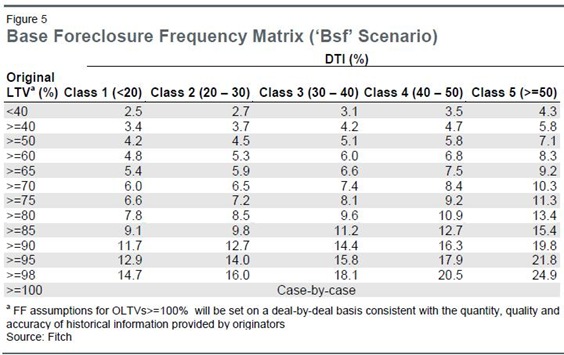
For example, the foreclosure frequency for borrowers with an original loan-to-value of 75% and a monthly repayment which consumers between 30% and 40% of their net income is expected to be 8.1%. The highest risk loans are clearly those with the highest original loan-to-values (now more than likely in significant negative equity) and the highest repayments relative to their income.
The imputed monthly repayment used to calculate the debt-to-income ratio could be a little high as the interest rate used is the “higher of 5.0% plus stabilised margin or the current Euribor rate plus stabilised margin”. With about half of Irish mortgages on ECB tracker rates the current rates are far lower than the equilibrium rate used by Fitch.
The ECB rate is not going to stay at the current lows but it will be some time before it is 5%+. This won’t change the relative risk of borrowers and is primarily used to put the borrowers into different debt-to-income classes. The default probabilities are also calculated using the base 10% foreclosure frequency as the starting point.
Fitch also make adjustments to the foreclosure frequency using a wide variety of other factors:
- Self-employed with/without verified income
- Prior bankruptcy or court judgement
- Interest only loan
- Payment holidays/restructured loans
Fitch don’t use an institution factor to distinguish between the banks. Although all mortgages are relevant only those in the covered banks will have an impact on the government’s accounts. The covered banks make up two-thirds of the Irish mortgage market and have a lower rate of arrears than the non-covered banks.
In last March’s stress tests carried out on the covered banks for the Central Bank, the base scenario used by BlackRock Consultants projected lifetime losses for the covered banks on the Irish mortgages of €9.7 billion. This was a 10% loss on the €97.5 billion of losses that were on their books at the time of the stress tests. Assuming a 50% recovery rate on defaulted mortgages this would be equivalent to a 20% foreclosure frequency.
The expected scenario of 20% mortgage defaults reported by Fitch yesterday is very similar to the base scenario used in the stress tests last March. In fact, under the stress tests the banks were recapitalised to satisfy an adverse scenario with a 16.7% lifetime loss rate, implying a default rate of nearly 35% of the loan book, well in excess of the rate expected by Fitch. As a result of last year’s recapitalisation the banks were covered for “three-year losses” under the adverse scenario and these were projected to be equivalent to 9.2% of the loan book.
The full document released by Fitch collates a lot of frequently used data on Irish mortgages and is an interesting read. We don’t get the details but it is clear that the headline 20% overall default rate for Irish mortgages is possible given the starting 10% default rate for ‘standard’ or performing loans in their expected scenario.

